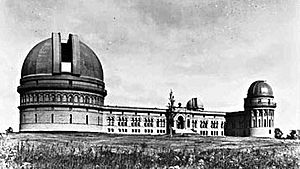Kenwood Astrophysical Observatory facts for kids
The Kenwood Astrophysical Observatory was a special place where a famous astronomer named George Ellery Hale studied the stars. His father, William E. Hale, built it for him in 1890. It was located right at their family home in the Kenwood area of Chicago.
At this observatory, George Ellery Hale used an amazing tool he invented called the spectroheliograph. This device helped him take pictures of the Sun's surface and atmosphere. He also started a very important science magazine here called the Astrophysical Journal.
The main telescope at Kenwood was a twelve-inch refractor. A refractor telescope uses lenses to gather light and make distant objects appear closer. Hale also had an assistant named Ferdinand Ellerman. Years later, they worked together again at the famous Mount Wilson Observatory.
Contents
What Was the Kenwood Observatory?
The Kenwood Astrophysical Observatory was George Ellery Hale's personal science lab. It was built just for him to explore the sky. This observatory became a very important place for astronomy in the late 1800s.
A Special Telescope
The main tool at Kenwood was its twelve-inch refractor telescope. This telescope was quite advanced for its time. It was even a "double telescope"! This meant it had two parts. One part was for looking at stars with your eyes. The other part was specially made for astrophotography, which is taking pictures of space.
Amazing Inventions
George Ellery Hale was not just an astronomer; he was also a brilliant inventor. He created the spectroheliograph while he was a student at MIT. This invention allowed scientists to study the Sun in new ways. It helped them see features on the Sun that were hard to observe before.
Hale also started the Astrophysical Journal at Kenwood. This journal became a leading publication for astronomers to share their discoveries. It helped spread new ideas and research about space.
Moving to a Bigger Home
George Ellery Hale's work at Kenwood became very well known. Many other astronomers were interested in what he was doing. When he became a professor at the University of Chicago, some advanced students used the Kenwood Observatory for their studies.
Later, a much larger observatory was built called Yerkes Observatory. It opened in 1897 in Williams Bay, Wisconsin. When Yerkes Observatory was ready, the telescopes and equipment from Kenwood were given to the University of Chicago. They were then moved to the new Yerkes facility.
The Kenwood Telescope at Yerkes
The twelve-inch refractor telescope from Kenwood was one of the first important instruments at Yerkes Observatory. It was placed in the north dome of the observatory. Even though it was later replaced by a larger 24-inch reflector telescope, the Kenwood telescope played a key role in the early days of Yerkes.


